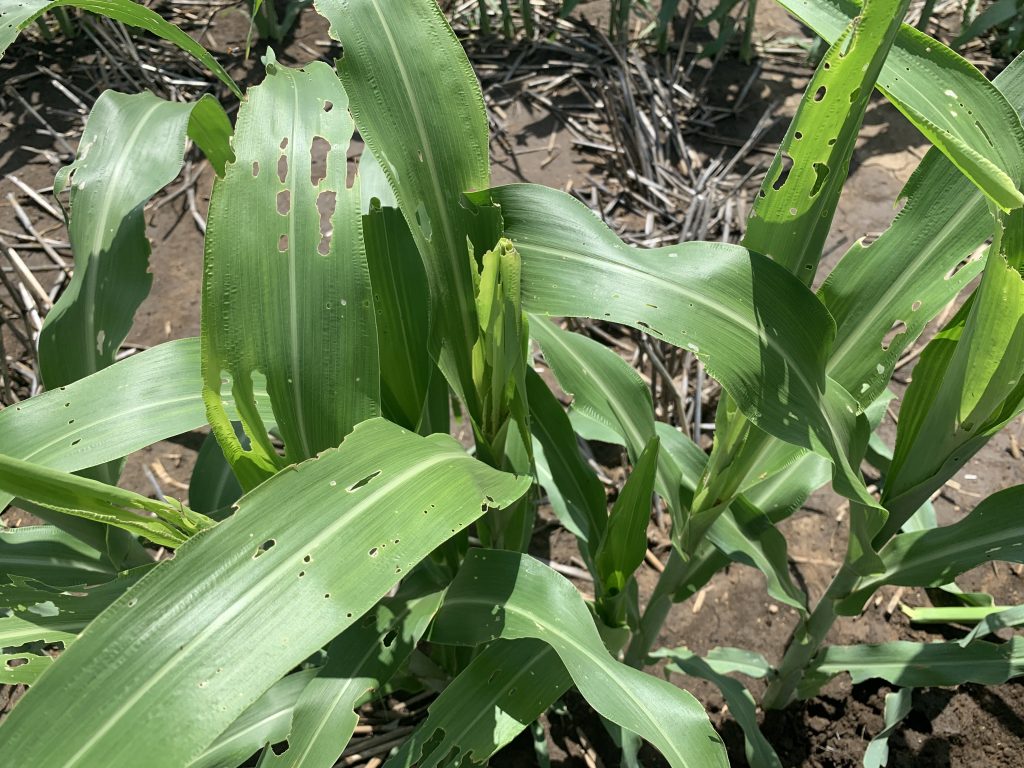Sorghum is a host of fall armyworm (FAW), but internationally it is not as severely impacted as maize. Like maize, sorghum is at greatest risk of crop loss at crop establishment (up to 4-5 leaves) as a result of persistent defoliation and seedling death. Crops destined for grain, as well as forage or silage are at risk. Whilst crops can experience significant defoliation during the vegetative stage, the impact of this on yield is unclear at this point. The development of economic thresholds for FAW in sorghum is the focus of current research.
FAW has a preference for vegetative crops, but larvae are found in heads from flowering through grainfill. Reported damage in sorghum has been similar to that found in maize, but usually of lesser severity. Populations of FAW tend to decline as sorghum approaches head emergence, however the 23-24 season has seen high population pressures and feeding in the panicle, including on relatively mature grain.

FAW damage in sorghum. Photo by Melina Miles.
What to look for
Early detection is essential. Regularly check your crops for eggs, larvae and damage.
Damage includes ‘windowing’ of leaves by young larvae, ‘shot hole’ damage to unfurling leaves, lower stem damage to seedlings and some damage of heads, mainly before they are fully emerged.
Monitor for fall armyworm in sorghum as you would for Helicoverpa armigera, paying particular attention to signs of infestation at the establishment stage. Fall armyworm damage to young sorghum plants will impact plant growth and yield if pest pressure is high and defoliation severe and persistent, or stem damage occurs. Seedling death can occur if medium – large larvae develop prior to V6. If crops are not heavily defoliated early, they can better tolerate defoliation in later vegetative stages.
FAW cause large, irregular-shaped holes in leaves emerging from the whorl. Helicoverpa armigera and other armyworm species will cause similar damage in sorghum. It is important to open up the whorl in order to accurately identify the larvae. Decisions must not be made on the presence of damage alone. Damage will persist after larvae have completed development and left the plant.
See the FAW damage page for pictures of crop damage.
Management
Establishing crops are very vulnerable to FAW damage. It is essential to prevent medium and large larvae developing in seedling crops. Severe defoliation at the seedling stage will compromise the rate of crop growth. Larger larvae will feed at the base of the plants and can damage the growing point, resulting in seedling death. Plant death does not typically result from larval feeding in the whorl.
Chemical control of FAW is most likely to be effective when targeting larvae feeding in exposed sites on smaller plants. Use banding, if appropriate, to optimise application in young crops and reduce the cost of the treatment. Products with residual activity will make it more likely that larvae emerging at night to feed on plants (from the soil or the whorl) will encounter a lethal dose of insecticide on exposed leaf surfaces. Just how much movement and feeding on exposed surfaces there is by larvae ‘entrenched’ in whorls is unclear.
An integrated pest management approach is key to the control of any pest. The Department of Agriculture and Fisheries is working with industry to identify appropriate thresholds and the most effective management strategies for Australian conditions. In the meantime, if an infestation occurs during the grain fill stage, use the Beatsheet’s Helicoverpa economic threshold calculator. It is likely that this overestimates the losses caused by FAW, but is a useful starting point for minimising crop loss until we have empirical local data.
While insecticides used for the control of other caterpillar pests may provide some level of control of FAW, the population that arrived in Australia is already known to be resistance to some chemical groups, including synthetic pyrethroids, organophosphates and carbamates. When choosing insecticides with which to target FAW, consider the implications for chemical resistance development in other pests (including Helicoverpa) that may be incidentally exposed to the insecticide application. As we already know there is a suite of natural enemies attacking FAW, preserving these is of value, so consider the potential impact of the insecticides on these natural enemies.
The APVMA has issued several permits for FAW in a range of crops. Check the APVMA’s permit portal for more details (search for ‘fall armyworm’ and tick the ‘pest/purpose’ button).
